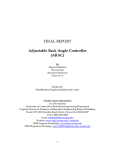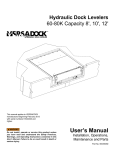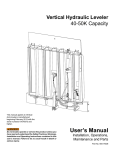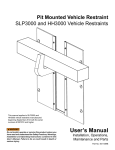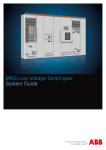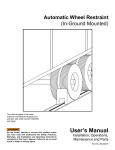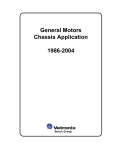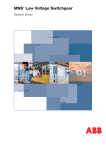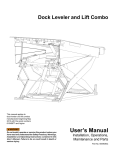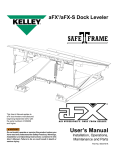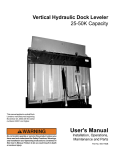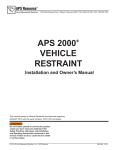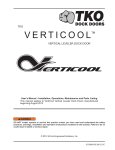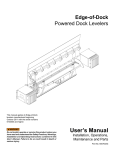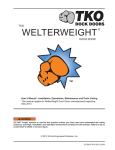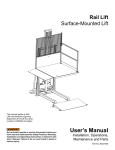Download User`s Manual - Curlin, Inc.
Transcript
Hydraulic Rail Leveler This manual applies to Hydraulic Rail Levelers manufactured beginning April 2012 with the serial numbers 61043720 and higher. Do not install, operate or service this product unless you have read and understand the Safety Practices, Warnings, and Installation and Operating Instructions contained in this User’s Manual. Failure to do so could result in death or serious injury. User’s Manual Installation, Operations, Maintenance and Parts Part No. 6003936K table of contents Introduction . ...............................................................2 Safety Signal Words ...................................................2 Safety Practices .........................................................3 Owners Responsibilities..............................................4 Working Range............................................................5 Installation...................................................................6 Components and Specifications ............................... 10 Hydraulic System Operation . ................................... 11 Operations.................................................................12 Service Tools ............................................................16 Planned Maintenance................................................17 Troubleshooting Guide..............................................20 Main Cylinder - Adjustment to Align Lock-Out Pin..... 24 Hydraulic System Bleed Procedure . ........................ 25 PLC Diagnostics .......................................................28 Hydraulic Power Unit Adjustment ............................. 30 Hydraulic Schematic . ...............................................32 Parts List...................................................................34 Warranty....................................................................51 Distributor Information...............................................52 introduction Welcome and thank you for choosing this hydraulic rail leveler for your material handling applications. This User’s Manual contains information that you need to safely install and identify parts for the hydraulic rail leveler. Please read and follow this User’s Manual when installing the hydraulic rail leveler. safety signal words You may find safety signal words such as DANGER, WARNING, CAUTION or NOTICE throughout this Owner’s Manual. Their use is explained below: This is the safety alert symbol. It is used to alert you to potential personal injury hazards. Obey all safety messages that follow this symbol to avoid possible death or injury. Indicates an imminently hazardous situation which, if not avoided, will result in death or serious injury. Indicates a potentially hazardous situation which, if not avoided may result in minor or moderate injury. Indicates a potentially hazardous situation which, if not avoided, could result in death or serious injury. Notice is used to address practices not related to personal injury. 2 ©2012 4Front Engineered Solutions, Inc. 6003936K — Hydraulic Rail Leveler July 2012 safety practices OPERATION (continued) Read these Safety Practices before installing, operating or servicing the dock leveler. Failure to follow the Safety Practices could result in death or serious injury. If you do not understand the instructions, ask your supervisor to explain them to you or contact your local authorized distributor. OPERATION Restrict use of dock leveler to trained operators. Follow safe operating procedures described in this manual and in the operation placard which was shipped with the leveler. The placard should be posted near the leveler. If either labels or placard is lost, contact your local authorized distributor for a replacement. Do not use the dock leveler to service rail cars outside of its intended working range. See page 5. Do not operate the dock leveler when anyone is in front of it. Do not operate the dock leveler with equipment, material or people on the ramp or lip. Stay clear of the dock leveler when it is moving. KEEP HANDS CLEAR OF HINGES AT ALL TIMES. Do not use hands to position dock leveler ramp or lip, or to store dock leveler. Do not use the dock leveler if it appears damaged or does not operate properly. Inform your supervisor immediately. Do not attempt to manually lift the dock leveler ramp or lip. If the dock leveler does not operate correctly using the operational procedures contained in this manual, do not use the leveler. Refer to the troubleshooting guide in this manual. If Leveler still does not operate properly call an authorized service representative. Do not stand in the area between the dock leveler and the rail car. Never drive on dock leveler unless green light is lit on the dock leveler control panel and the rail car supports the extended lip or the ramp is supported by the extendable arms. July 2012 Always restore leveler to its safe stored vertical position with lip extended and LEVELER Stop button pressed after servicing rail car. DO NOT walk in front of dock leveler until you: • Restore the leveler to its safe stored vertical position with lip extended. • Press LEVELER Stop button to stop the leveler and lip from moving. • Secure the maintenance strut with padlocked lock-out pin. Move all equipment, material or people off the dock leveler and store the dock leveler after use. Do not use a fork truck or other material handling equipment to lower the leveler. INSTALLATION, MAINTENANCE AND SERVICE Place barricades on the dock floor around the dock leveler and in the area in front of the dock leveler while installing, maintaining or repairing the dock. If the leveler is left in a disabled condition, the lock-out pin must be padlocked in position. Do not operate the dock leveler when anyone is standing in front of the dock leveler. Before doing any maintenance or repair under the leveler be certain that the leveler is stored with the lock-out pin inserted through the maintenance strut and bracket on the deck, the LEVELER Stop button is pressed, the power is disconnected and properly tagged or locked out, and barriers are in place. Disconnect the power and properly tag or lock out before doing any maintenance or electrical work on the leveler. All electrical troubleshooting or repair must be done by qualified technician and must meet applicable codes. If it is necessary to make troubleshooting checks inside the control box with power on, USE EXTREME CAUTION! Do not place fingers or uninsulated tools inside the control box. Touching wires or other parts inside the control box could result in electrical shock, serious injury or death. Prior to complete electrical and hydraulic installation, levelers should be stored safely. If leveler is stored vertically, the lock-out pin must be inserted through the maintenance strut and the bracket on deck, and secured with a padlock until the leveler is completely wired, tested, and fully operational. 6003936K — Hydraulic Rail Leveler ©2012 4Front Engineered Solutions, Inc. 3 OWNER’S RESPONSIBILITIES The owner’s responsibilities include the following: The owner should recognize the inherent danger of the interface between dock and rail car. The owner should, therefore, train and instruct operators in the safe use of dock leveling devices. When a rail car is positioned at the dock, there shall be at least 4" of overlap between the front edge of the lip of the dock leveler and the edge of the floor or sill of the transport vehicle. Nameplates, cautions, instructions and posted warnings shall not be obscured from the view of operating or maintenance personnel for whom such warnings are intended. Manufacturer’s recommended periodic maintenance and inspection procedures in effect at time of shipment shall be followed, and written records of the performance of these procedures should be kept. A dock leveler that is structurally damaged or has experienced a sudden loss of support while under load, such as might occur when a transport vehicle is pulled out from under the dock leveler, shall be removed from service, inspected by the manufacturer’s authorized representative, and repaired as needed before being placed back in service. The owner shall see that all nameplates, caution and instruction markings or labels are in place and legible and that the appropriate operating and maintenance manuals are provided to users. Modifications or alterations of dock leveling devices shall be made only with written permission of the original manufacturer. The dock leveler should never be used outside its vertical working range or outside the manufacturer’s labeled rated capacity. It must also be compatible with the loading equipment and other conditions relating to the dock. 4 ©2012 4Front Engineered Solutions, Inc. 6003936K — Hydraulic Rail Leveler July 2012 working range Fig. 1 Ramp grade Lip grade Above dock Rail floorDeck and lip grades, % for centerline length position from dock 99" CL 108" CL 120" CL Deck LipDeck LipDeck 6" 17.6 11 14.1 7.6 12.3 4" 13.2 6.1 10.5 3.6 8.7 2" 8.2 1.2 7.0 0.0 5.2 Lip 5.2 1.7 -1.7 0" 3.3 -3.7 2.8 -4.2 2.3 -4.7 -1.7 -6.1 -11.4 -8.7 -13.2 -18.5 -0.9 -5.2 -8.7 -7.9 -12.3 -15.8 -0.7 -4.2 -7.0 -7.7 -11.2 14.0 Below dock 2" 4" 6" Deck and lip grade 4º crown, 20" lip. July 2012 6003936K — Hydraulic Rail Leveler ©2012 4Front Engineered Solutions, Inc. 5 installation INSTALLATION OF DOCK LEVELER Before installing the dock leveler, read and follow the Safety Practices on page 3 and the operation section in this manual. Important Installer Responsibility: Prior to complete electrical and hydraulic installation, levelers must be stored safely. If leveler is mounted on hinges and stored vertically, maintenance strut must be secured with lock-out pin and padlock until the leveler is completely wired, tested and fully operational. Padlock must not be removed until leveler is completely wired, tested, and fully operational. Failure to follow Safety Practices could result in death or serious injury. Make sure lifting devices are in good condition and have a rated capacity of at least 3000 lb. at the lifting angle they are being used. Stand clear of the dock leveler when it is being placed into the pit. Never allow anyone to stand on or near the dock leveler when it is being lifted or placed into the pit. The dock leveler can tip or swing into bystanders which could result in death or serious injury. Fig. 2 GENERAL INFORMATION The successful installation of a dock leveler requires good coordination with other trades involved on the site. You must have a clear access to the dock area, inside and out. Ideally, the leveler should not be installed until the control panel is installed, has live power connected to the control panel, and field wiring to the power unit is complete. This will allow the complete installation at one time as opposed to making several trips. 3/4"-UNC load centering eyebolt The installed location of the control panel must be specified on a job specific “Approval Drawing”. Check with the general contractor or sales person for this information. SITE CHECK Check the entire mounting site for proper construction according to the job specific approval drawings. Check electrical service running to the control panel to ensure it agrees with the phase and voltage of the motor and control box supplied with the dock leveler. Check the control panel for wiring diagram, if unable to locate, follow the schematics located in this manual. Rigging hooks (2) Take care when moving the dock leveler to ensure that the electrical and hydraulic components are not damaged. 6 ©2012 4Front Engineered Solutions, Inc. 6003936K — Hydraulic Rail Leveler July 2012 installation, continued HANDLING AND UNLOADING The rear embed channel or track will be installed first by the concrete contractor. In most cases, these components will have arrived at the site much earlier than the levelers. The levelers will arrive on a truck laid flat with the hydraulic cylinders facing upward. Spacers will be inserted between the levelers to prevent damage to the leveler components. The levelers can be lifted off the truck in stacks of three. Using the forks to separate the levelers is not recommended as damage to the hydraulic components may occur. The levelers should be lifted individually by installing a 3/4" UNC load centering eyebolt through the hole supplied in the lip plate. See Fig. 2. 5.Once the carriage is mounted and the stop bolts are secured, use the load-centering eyebolt and carefully raise the leveler to the stored position. Fit the lock-out pin through the hole in the end of the maintenance strut and the bracket on the deck. Place a padlock through the hole provided in the lock-out pin. See Fig. 5. This will prevent any unauthorized activation of the leveler and is essential to the personal safety of anyone near this leveler. Replace the main cylinder lower clevis pin that was removed in step 2. Fig. 3 TO INSTALL 1.Mount and wire the control panel in the location as shown on the job specific approval drawing. Ensure that the voltage and phase of the incoming power agrees with the control panel and the decals on the pump and motor. Power to the control must come from a user supplied fused disconnect with correct fuse sizes for the voltage and phase of the motor. See electrical diagram for correct fuse size. Make sure there are no obstructions at the ends of the rail section since you will be sliding it on to the end of the rail. 2.Pick up the leveler using the load-centering eyebolt and suspend the leveler as shown in Fig. 2 using the eyebolt and two rigging hooks. Unpin the main cylinder on the rod end. See Fig. 23. The carriage can be allowed to rotate if desired after unpinning the main cylinder rod end from the carriage. Tie the loose end of the cylinder with wire so it does not swing. The carriage can also be held in position using the pin through the slot in the maintenance strut. See Fig. 3. 3.Align the carriage rollers with the track and feed the carriage onto the end of the rail section. Ensure the rollers in the carriage contact the rail properly. See Fig. 4. Fig. 4 Carriage rollers Fig. 5 4.Once the leveler is mounted, you must install the stop bolts at the end of the rail section which will prevent the leveler from sliding off the end of the rail. See Fig. 10. The lock-out pin must be inserted through the slot in the maintenance strut and the bracket on the deck. The pin must be secured with a padlock before the lifting device is removed. Failure to do so could result in death or serious injury. See Fig. 5 for lock-out pin location. July 2012 6003936K — Hydraulic Rail Leveler ©2012 4Front Engineered Solutions, Inc. 7 installation, continued 6. For levelers built with manual side-shift, install the brake pad and steel plunger into the guide tube indicated in Fig. 6. Adjust brake bolt to prevent rail leveler movement when in working range. The steel disk must contact the adjustment bolt. Too much pressure on brake pad can cause damage. Fig. 6 6B. OPTIONAL HYDRAULIC SIDE SHIFT MODELS ONLY With the rail ramp in the stored vertical position with the side shift cylinder fully retracted and the leveler shifted fully right as shown in Fig. 18, attach the side shift cylinder to the mounting bracket with pin, cotter and washer as shown on page 43 and anchor the bracket with the 4 supplied 3/4" concrete anchors as shown in Fig. 7 and page 43. Brake bolt Guide tube 7. Remove the lifting device from the leveler lip. Leave the lip fully extended. Do not remove the lock-out pin from the maintenance post until steps 8 through 11 have been completed to ensure that the leveler is functioning properly. Failure to do so could result in death or serious injury. 8. Connect wires from control box to motor, solenoid manifold and if present, side shift solenoid. Ensure that wires have free movement through the entire carriage operating range before terminating. See electrical schematics located in this manual. Fig. 7 9. Remove shipping plug from the hydraulic reservoir and replace with the dipstick breather cap. 10.Pull out the LEVELER STOP button. The AMBER power light should be on. Press and hold the RAISE button for 5 seconds only. The main cylinder should be fully extended. 11. Ensure that the area in front of the leveler is clear. Remove the padlock from the lock-out pin. Press and hold the RAISE button until the maintenance strut pin slides freely. If the pump motor runs and the leveler does not move, the motor is likely turning in the wrong direction. Disconnect electrical power and switch motor wires to reverse rotation. (refer to troubleshooting guide and electrical schematics in this manual). Stand at the side of the leveler, reach in and remove the lock-out pin from the maintenance strut. 8 ©2012 4Front Engineered Solutions, Inc. Anchor holes 6003936K — Hydraulic Rail Leveler July 2012 installation, continued 12.Press and hold the LOWER button. The pump will run and the leveler will move forward and start to lower. The horn will sound if the leveler is stopped between the lowered working range and the stored position. Continue to press the LOWER button until the pump stops. The leveler will hesitate momentarily when it reaches the working range, then continue to float down. Observe the lowering speed of the leveler after it reaches the working range. The leveler lowering speed in the working range should match the leveler power down portion of the lowering. Adjust needle valve as necessary, see pages 30-31. The GREEN light on the control panel should be on while in the working range. 13.Press and hold the Raise button until the leveler is raised above the working range and the Green light goes off. Release the button. The leveler should remain in position and the horn should sound. Press and hold the RAISE button until leveler is fully raised and lip is extended. 19.Clamp the new brace in position, perpendicular to the wall. Leave a 1/8"-1/4" gap between the brace and the wall. Weld the brace securely to the leveler frame. NOTE: Make sure the welding machine’s ground clamp is attached to the carriage assembly and not on the leveler. 20.Permanently mount the laminated DANGER and OPERATION instruction placard near the dock leveler control panel. Make sure the customer gets the User’s Manual and is properly trained. Fig. 8 14.Cycle the leveler from full up to full down 4 times. 15.Raise the leveler to the stored position. Fit the lock-out pin through the leveler deck bracket, through the hole (not the slot) in the maintenance strut, securing the maintenance strut. Lockout and tag the lock-out pin. Press the LEVELER stop button. See page 16. 16.Check the reservoir fluid level with the leveler in the stored position with the lip extended (and hydraulic sideshift cylinder, if equipped, fully positioned to the right). The fluid level should be between the fill marks on the dip stick when using the fluid check procedure on page 17. Only use fluids specified on page 18. 1/4" gap to Wall 1/2" for manual side shift 4" for hydraulic side shift (Must clear side shift cylinder, do not obstruct side shift pin) 3/16" Fig. 9 17.The proper stored position shall be as shown in Fig. 9. The leveler deck should rest between 2° and 5° past vertical center line. The cylinder should be fully extended and the lockout pin free to slip in/out of deck bracket. Refer to maintenance section on page 24 for adjustment procedures. Store position 2°-5° over center install the main cylinder support 18.Measure the wall run out. To do this, clamp the included wall bumper to the side of the cylinder mount near the main cylinder’s lower clevis pin. See Fig. 8. Orient the bar so it is perpendicular to the wall and nearly touching the wall. Leave approximately a 1/8"-1/4" gap to the wall. Have an assistant slide the leveler frame to the left and righthand limits of travel as you observe the bar's proximity to the wall. Find the spot on the wall where the gap is the smallest. It may be necessary to adjust the bar's position slightly if it scrapes the wall. Leave the leveler in this spot. July 2012 6003936K — Hydraulic Rail Leveler ©2012 4Front Engineered Solutions, Inc. 9 COMPONENTS AND SPECIFICATIONS The main components of the leveler are shown below. See the Parts List for specific part numbers. Fig. 10 Lip plate Deck assembly Lip cylinder Lip hinge Carriage stop bolt hole Carriage assembly Main lift cylinder Adjustable rod end Fig. 11 Control Panel Maintenance strut Track assembly Carriage stop bolt hole Raise (Blue Push-button) Lip Extend (Green Push-button) Lip Retract (Black Push-button) Lower (Yellow Push-button) Leveler Stop (Red Push/Pull Mushroom Style Push-button) 10 ©2012 4Front Engineered Solutions, Inc. 6003936K — Hydraulic Rail Leveler July 2012 COMPONENTS AND SPECIFICATIONS , continued Control Panel (Standard) - NEMA 12, motor starter, thermal overload, U.L. approved. Cycle Times - Lower: 16 sec. (±3 sec.); Raise: 30 sec. (±5 sec). Pilot Light - LED. Reservoir Capacity - 1 U.S. gal., (3.8 lit.) level measured by dipstick. Solenoid Valves - 24VAC. Motor - NEMA Standard T.E.N.V. / 48YZ frame, 1 h.p. @ 15 mi. duty cycle, single or three phase. Pump - Fixed displacement gear pump, 1 gpm, primary relief valve factory set at 2500 PSI, sequence valve factory set at 2000 PSI. Hydraulic Fluid - Acceptable Hydraulic fluids: Shell Tellus T 15 Mobil Aero HFA (49011) Exxon Univis Grade J13 Texaco Aircraft Oil #1554 U.S. Oil Co., Inc #ZFI-5606 (Low Temp.) HYDRAULIC SYSTEM OPERATION AUDIBLE HORN • Sounds when leveler stops between float and fully stored position. • Will silence when leveler is raised to stored position or LEVELER STOP is pressed. LEVELER STOP BUTTON Push in • Control circuit disabled. • Amber pilot light turns off. • Solenoid valves SV2 and SV3 deenergize preventing leveler movement. Pull out • Control circuit disabled. • Amber pilot light turns on. • Main solenoid valves SV2 and SV3 remain closed except when pump is running or leveler is lowered to working range. LOWER Button • Pump starts. • Power down solenoid valve SV1 opens to retract main cylinder. When leveler lowers to working range, the pumps stops, the power down solenoid valve SV1 closes and Main solenoid valves SV2 and SV3 open to allow leveler to float down to rail car floor. • Green pilot light turns on when leveler reaches working range RAISE button • Pump starts. • Main solenoid valves SV2 and SV3 open to extend main cylinder. • Green pilot light turns off when leveler raises above working range. July 2012 Fully Raised • Leveler stored sensor closes. • Pressure increases • Sequence valve shifts • Lip cylinder extends. LIP RETRACT button • Pump starts fluid directed to lip circuit. • Lip solenoid SV4 energizes and opens. • Once the lip reaches full retract the pressure increases until the sequence valve shifts and the lip will begin to raise. • Green pilot light turns off when leveler raises above the working range. LIP EXTEND button • Pump starts and pressure flows to extend the lip. • Main cylinder solenoid valve is closed. • Pressure builds and extends the lip. Side Shift Left (side shift only) • Main solenoid valves SV2 &SV3 are opened. • SV5 solenoid valve shifts to divert flow to side shift cylinder •Pump starts and pressure flows to Extend the side shift cylinder. • Deck will shift left. Side Shift Right (side shift only) (Feature only available on assemblies with hydraulic side shift.) • Power down solenoid valves SV1 is opened. • SV5 solenoid valve shifts to divert flow to side shift cylinder. •Pump starts and pressure flows to retract the side shift cylinder. • Deck will shift right. 6003936K — Hydraulic Rail Leveler ©2012 4Front Engineered Solutions, Inc. 11 operations Before operating the dock leveler, read and follow the Safety Practices on page 3. Restrict use of dock leveler to trained operators. Follow safe operating procedures described in this manual and in the operation placard which was shipped with the leveler. The placard should be posted near the leveler control panel. If either labels or placard is lost, contact your local authorized distributor for replacement. DO NOT USE DOCK LEVELER IF IT LOOKS DAMAGED, OR DOES NOT SEEM TO WORK PROPERLY. Inform your supervisor immediately. Always secure the rail car to make sure it cannot move before operating the dock leveler. Always keep hands and feet clear of all moving parts. Never drive on dock leveler unless GREEN LIGHT is lit on the dock leveler control panel AND rail car supports either the extended lip or both arm assemblies with at least 4" of overlap. Do not operate the dock leveler with anyone standing on or in front of it. DO NOT walk in front of dock leveler until you: • Restore the leveler to its safe stored vertical position with lip extended. • Press the LEVELER Stop button to stop the leveler from moving. Always return the dock leveler to its safe stored vertical position with lip extended with the LEVELER Stop button pressed and the GREEN and AMBER LIGHTS OFF after servicing rail car. Failure to observe these warnings could result in death or serious injury. If the dock leveler will not raise with the RAISE pushbutton, and it must be raised by external mechanical means to close the dock door, use extreme caution and do not allow anyone to stand in front of the leveler. Ensure that the lock-out pin is inserted through the maintenance strut and bracket on deck before the mechanical lifting means is removed. 12 ©2012 4Front Engineered Solutions, Inc. During lifting of the leveler by mechanical means it is likely that hydraulic fluid will vent itself through the breather of the hydraulic reservoir. Lift the leveler slowly and without getting in front of the leveler, place a container under the reservoir if possible to catch the fluid. The lock-out pin must not be removed until the hydraulic system has been bled of air and all hydraulic functions have been tested by a qualified service technician. If the dock leveler has been raised to the stored position by external means, the main cylinder will be full of air and there may be a vacuum exerting a strong retracting force on the cylinder rod. A technician will need to perform a bleed procedure to remove the air from the hydraulic cylinder. With the lock-out pin in place, the technician should loosen the hydraulic hose fitting on the top port of the main cylinder and allow air to fill the vacuum before attempting to remove the pin from the cylinder rod (lower) end. With the lock-out pin in place, the technician must remove the pin from the main cylinder rod (lower) end and perform the cylinder bleed procedure shown on page 25-27. Failure to follow this instruction can allow the leveler to free fall rapidly and may result in severe injury or death. INTRODUCTION The hydraulic rail leveler is designed to span and compensate for space and height differences between a loading dock and rail car floor to allow safe, efficient freight transfers. The hydraulic rail leveler uses push-button controls to raise and lower the ramp. Pressing and holding the Lower button operates a hydraulic pump and retracts a hydraulic cylinder to lower the ramp. When the ramp is lowered to the working range, it floats down to rest on the rail car floor forming a bridge. After loading, pressing and holding the Raise button extends the hydraulic cylinder to raise the ramp to the stored position. When the dock leveler reaches its full raised position, a second hydraulic cylinder extends the dock leveler lip. Push the LEVELER Stop when the leveler is stored to prevent operation. With the dock leveler in its fully stored position, a maintenance strut may be secured with a lock-out pin to prevent inadvertent operation. Before lowering, the leveler can be side shifted manually within a certain range (if necessary) to line up with the opening in the rail car. (hydraulic side shift is an option.) 6003936K — Hydraulic Rail Leveler July 2012 operations, continued Normal Operation 1. To lower the dock leveler pull the LEVELER STOP button on control panel to switch on power. Amber light indicates power on. Press and hold LOWER button. The pump will start and the leveler will start to lower. Release the LOWER button when the Green light on the control panel turns on. (Green light on leveler control panel indicates leveler has reached operating range) The leveler will float down to the rail car floor. See Fig. 12. 2. To stop the leveler, release the LOWER button. Audible horn will sound if the button is released before the leveler is in its operating range. Push the LEVELER STOP button at any time to stop all operation and silence the audible horn. If this condition persists, a short duration tone will sound periodically to remind the operator of the illegal leveler condition. Amber and green lights will turn off. To resume operation of the leveler, pull the LEVELER STOP button (amber light on) and press and hold the LOWER button and leveler will float down to the rail car floor. Release the LOWER button when Green light on leveler control panel indicates leveler has reached the operating range. See Fig. 13. Fig. 12 Press Lower button Pull for power on Fig. 13 Press to lower Push to stop Pull for power on NOTE: Audible horn pulses and green lamp goes off if the LEVELER Stop button is pressed while leveler is in float range. Amber lamp flashes if both LS1 and LS2 are on or an overload condition exists. Never drive on dock leveler unless GREEN LIGHT is lit on the dock leveler control panel AND rail car supports either the extended lip or both arm assemblies with at least 4" of overlap. July 2012 6003936K — Hydraulic Rail Leveler ©2012 4Front Engineered Solutions, Inc. 13 operations, continued 3.To return the leveler to its vertical stored position, press and hold the RAISE button. Green light will turn off. Audible horn will sound if the button is released before the leveler is fully raised. When the leveler is fully raised and the lip is extended, release the RAISE button. Push the LEVELER STOP button to turn off power (amber light off). See Fig. 14. Fig. 14 Press Raise button Push for power off End Loading Operation 1.If the leveler lip will interfere with adding or removing a pallet, an end load must be performed. Pull the LEVELER STOP button to switch on power. Amber light indicates power on. Press LOWER button until the leveler is partially lowered. Press LIP RETRACT button until lip is fully retracted. Press LOWER button until leveler is just above working range. Push in LEVELER STOP button to halt leveler movement. Extend both arm assemblies so that arms will land on the floor of rail car with at least 4" of overlap. Make sure the T-bolts are tightened. Pull out LEVELER STOP button and press LOWER button until GREEN light on leveler control panel indicates leveler has reached the operating range. Leveler will float down to the rail car floor. See Fig. 15. Fig. 15 Press to retract lip Press Lower button Pull for power on 2.To reposition the leveler for normal loading/unloading, press the RAISE button and hold until lip is clear of the rail car. Press the LEVELER STOP button. Retract both arm assemblies. Press the LIP EXTEND button until the lip is fully extended. Press and hold the LOWER button until GREEN light on leveler control panel indicates the leveler has reached the operating range. Leveler will float down to the rail car floor. See Fig. 16. 3.To return the leveler to its vertical stored position, press and hold the RAISE button. Green light will turn off. Audible horn will sound if the button is released before the leveler is fully raised. When the leveler is fully raised and the lip is extended, release the RAISE button. Push the LEVELER STOP button to turn off power (amber light off). See Fig. 14. 14 ©2012 4Front Engineered Solutions, Inc. Fig. 16 6003936K — Hydraulic Rail Leveler Press to raise Press to extend lip Push to stop Pull for power on July 2012 operations, continued HYDRAULIC SIDE SHIFT OPERATION (If equipped) The optional hydraulic side shift feature on the hydraulic rail levelers is operated by a hydraulic cylinder that positions the entire dock leveler left or right along the rail connected to the embed channel. Fig. 17 Side shift selector switch (Left/Right is viewed from the building side of the leveler) Ensure the leveler is stored in the upright vertical position. Turn selector switch left or right to position the leveler along the rail. When lip is aligned with the area of the railcar to form a bridge, release the selector switch. Proceed with leveler use. Fig. 18 Shift left July 2012 Shift right 6003936K — Hydraulic Rail Leveler ©2012 4Front Engineered Solutions, Inc. 15 service tools Fig. 19 Before servicing the dock leveler, read and follow the Safety Practices on page 3 and the Operation section in this manual. Before doing any maintenance or repair on the dock leveler, be certain that: 1) THE LEVELER IS STORED IN THE VERTICAL POSITION WITH THE LIP EXTENDED AND THE LOCK-OUT PIN INSERTED THROUGH THE MAINTENANCE STRUT AND BRACKET ON DECK. 2) The LEVELER Stop button is pressed. 3) Barriers are in place. 4) The power is disconnected and properly tagged or locked out. Failure to do so could result in death or serious injury. Maintenance strut The vertical dock leveler is equipped with a maintenance strut to hold the leveler in the stored position during maintenance. Always follow the procedure below when performing maintenance or adjustments of any kind to the dock leveler. 1. Raise the leveler to its fully stored position with the lip extended. 2. Press the LEVELER Stop button on the control panel. 3. Swing the maintenance strut into position and insert the lockout pin through the hole (not the slot) in the maintenance strut and the bracket on the deck (reach from the side of the leveler while inserting lock-out pin). The lock-out pin should insert freely. 4. Place a padlock through the hole in the lock-out pin to prevent accidental activation of the dock leveler. See Fig. 19. 5. Place barricades around the dock leveler to show leveler is out of service. 16 ©2012 4Front Engineered Solutions, Inc. 6003936K — Hydraulic Rail Leveler July 2012 planned maintenance Before servicing the dock leveler, read and follow the Safety Practices on page 3 and the Operation section in this manual. Before doing any maintenance or repair on the dock leveler, be certain that: 1) THE LEVELER IS STORED IN THE VERTICAL POSITION WITH THE LIP EXTENDED AND THE LOCK-OUT PIN INSERTED THROUGH THE MAINTENANCE STRUT AND BRACKET ON DECK. 2) The LEVELER Stop button is pressed. 3) The power is disconnected and properly tagged or locked out. 4) Barriers are in place. Failure to do so could result in death or serious injury. WEEKLY quarterly 1. Check that the lock out pin can be freely inserted through the maintenance strut and the bracket on the deck when the leveler is fully raised. 1. Inspect and lubricate all mechanical pivot points on the leveler with S.A.E. 30 oil. Cycle the leveler when lubricating. See Fig. 20. 2. Check the full operation of the leveler to ensure there is no hesitation in the hydraulic system. Any loss of fluid will affect the safety valve operation. 2. Inspect the hydraulic cylinders, valves and hoses for any leaks or chaffing. Check the reservoir fluid level with the leveler in the stored position with the lip extended. If hydraulic side shift is present, the leveler should be fully positioned to the right. Unscrew the oil level dip stick and remove. Wipe the dipstick clean. Re-insert the dipstick into the reservoir but do not screw in. Read the dipstick. The fluid level should be between the fill marks. Refill as required using only the fluids specified on page 18. 3. Verify both control panel indicator LEDs are working. Replace if necessary. 4. Clean away any debris from the operating area. If washing out, take care not to direct spray at any electrical parts. See page 18. 5. Clean away any dirt and debris from the lip hinge. See page 18. 3. Inspect all welds under leveler for fatigue or failure, particularly the lip plate hinge and under the top plate. 6. Clean away any dirt and debris from the surfaces of the wall mounted track so the leveler will slide freely from side to side. See page 18. 4. Inspect all safety labels and placard. Replace as required. See page 19 for part numbers and label location. July 2012 5. Grease all locations shown on page 18. 6003936K — Hydraulic Rail Leveler ©2012 4Front Engineered Solutions, Inc. 17 planned maintenance, continued Hydraulic Fluid - Acceptable Hydraulic fluids: Shell Tellus T 15 Mobil Aero HFA (49011) Exxon Univis Grade J13 Texaco Aircraft Oil #1554 U.S. Oil Co., Inc #ZFI-5606 (Low Temp.) Legend Symbol Description Lubricate - Oil Light Oil - SAE 30 Lubricate - Grease Molybdenum Disulfide NLGI #2 Oil level dip stick Cleaning (Location - Frequency) Visually Inspect (Replace Damaged Or Worn) Fig. 20 Pins Lip hinge weekly Pin Hoses quarterly Track weekly Hinge pins (4 places) Rollers (6 places) 18 ©2012 4Front Engineered Solutions, Inc. Spiral wrap annually 6003936K — Hydraulic Rail Leveler Maintenance strut (1 place) July 2012 planned maintenance, continued Fig. 21 6007867 6004112 6000873 6004101 824-001 July 2012 WARNING AND OPERATION PLACARD (MOUNTED NEAR CONTROLS) 6003936K — Hydraulic Rail Leveler ©2012 4Front Engineered Solutions, Inc. 19 troubleshooting GUIde Use the Troubleshooting Guide if ever the leveler fails to perform properly. Find the condition that most closely matches your situation and make the recommended adjustments. Observe all safety warnings before attempting any maintenance procedure. Before servicing the dock leveler, read and follow the Safety Practices on page 3 and the Operation section in this manual. Be certain before doing any maintenance or repair on the dock leveler, that: 1) THE LEVELER IS STORED IN THE VERTICAL POSITION WITH THE LIP EXTENDED AND THE LOCK-OUT PIN INSERTED THROUGH THE MAINTENANCE STRUT AND BRACKET ON DECK and 2) The power is disconnected and properly tagged or locked out. Do not enter the area in front of, or under the leveler unless the leveler is fully raised and lip extended, lock-out pin is inserted through the maintenance strut and bracket on deck, the lEVELER Stop button is pressed, and barriers are in place. attempting to remove the pin from the cylinder rod (lower) end. With the lock-out pin in place, the technician must remove the pin from the main cylinder rod (lower) end and perform the cylinder bleed procedure shown on page 25-27 Failure to follow this instruction can allow the leveler to free fall rapidly and may result in severe injury or death. Do not disconnect hoses unless the leveler is fully raised with lip extended, the lockout pin is inserted through the maintenance strut, LEVELER Stop button is pressed, and barriers are in place. After replacing hoses and/or motor/pump, cycle the leveler at least 4 times to remove air from the cylinder. After replacing hoses and/or motor/ pump, perform the cylinder bleed procedure shown on page 25-27 before removing the lock-out pin from the maintenance strut and bracket on deck. Failure to do so could result in death or serious injury. If the dock leveler will not raise with the RAISE pushbutton, and it must be raised by external mechanical means to close the dock door, use extreme caution and do not allow anyone to stand in front of the leveler. Ensure that the lock-out pin is inserted through the maintenance strut and bracket on deck before the mechanical lifting means is removed. During lifting of the leveler by mechanical means it is likely that hydraulic fluid will vent itself through the breather of the hydraulic reservoir. Lift the leveler slowly and without getting in front of the leveler, place a container under the reservoir if possible to catch the fluid. The lock-out pin must not be removed until the hydraulic system has been bled of air and all hydraulic functions have been tested by a qualified service technician. If the dock leveler has been raised to the stored position by external means, the main cylinder will be full of air and there may be a vacuum exerting a strong retracting force on the cylinder rod. A technician will need to perform a bleed procedure to remove the air from the hydraulic cylinder. With the lock-out pin in place, the technician should loosen the hydraulic hose fitting on the top port of the main cylinder and allow air to fill the vacuum before 20 ©2012 4Front Engineered Solutions, Inc. 6003936K — Hydraulic Rail Leveler July 2012 troubleshooting guide, continued Do not disconnect hoses or any hydraulic components unless the leveler is fully raised with lip extended, the lock-out pin is inserted through the maintenance strut, LEVELER Stop button is pressed, and barriers are in place. If you disconnect any hydraulic components remove the pin from the main cylinder and perform the Hydraulic System Bleed Procedure found on page 25-27 before removing the lock-out pin from the maintenance strut and bracket on deck. Failure to do so could result in death or serious injury. PROBLEM 1.Leveler does not raise or lower. Motor not running. 2.Leveler does not raise or lower; motor starts then stops, motor starter relay chatters. 3.Overload relay tripping (check full load amperage and relay setting). 4.Leveler does not raise or lower. Motor hums. July 2012 POSSIBLE CAUSE SOLUTION a) No electrical power to control panel. a)Check that voltage is present at terminal connections to the control panel. b)Electrical connections incorrect or broken. b)Check that wiring matches the wiring diagram. c)No electrical power to PLC. c)No electrical wiring to the PLC. d)PLC not running. d)If the fault light is flashing, replace PLC. e)Both leveler float and stored inputs ON. e)Inspect, repair or replace proximity sensors. a)Loose wiring connection. a)Check all wiring connections from line to motor starter relay, overload and to motor. b)Voltage drop due to long wiring distance from power source. b)Check voltage when motor is started. Voltage drop is more often a problem on single phase motors. Verify wire gage is adequate for length of wire. a)Overload relay set too low. a)Set overload to full load current specified for voltage on motor nameplate. b)Loss of 1 phase (Three phase only) b)Check for voltage at all three motor connections (T1, T2, T3) at output of overload in control panel. a)Voltage drop. a)See solution 2. b). b)Loss of 1 phase (Three phase only) b)Check for voltage at all three motor connections (T1, T2, T3) at output of overload in control panel. 6003936K — Hydraulic Rail Leveler ©2012 4Front Engineered Solutions, Inc. 21 troubleshooting guide, continued PROBLEM 5. Leveler does not raise or lower. Motor runs. POSSIBLE CAUSE SOLUTION a) Low fluid in reservoir. a) Check fluid level with leveler fully lowered. Oil level should be 1/2-3/4" below top of reservoir with lip pendant. Add oil if required. b)Main solenoid valve SV2 and/or SV3 does not open. b) Check for magnetism at solenoid coil. If magnetism present, remove and inspect valve for contamination and then replace solenoid valve. c) Pump running in reverse c) Check motor rotation and reverse electrical connections T1 and T2 if necessary. d) Pump damaged or broken internally. d) With the leveler safely secured by the lock-out pin inserted in the maintenance strut and bracket on deck, remove the hose from the upper port of the main lift cylinder and point free end into the reservoir opening. If no fluid is pumped, replace hydraulic power unit. e) Insufficient pressure. Primary relief valve (RV1) setting too low. e) Set primary relief valve (RV1) to 2500 PSI. See page 30 and 31. a)Lower solenoid valve SV1 does not open. a)Check for magnetism at solenoid coil. If magnetism present, remove and inspect valve for contamination and then replace solenoid valve. b) NV1 (needle valve) set too tight. b)Adjust NV1 (needle valve) CCW. See hydraulic power unit adjustment on pages 30-31. 7. Leveler floats down too fast or too slowly in “float” range. a) Needle Valve FNV requires adjustment. a) Adjust Needle Valve FNV. Turn counter clockwise to increase lowering speed or clockwise to decrease speed. The speed of the deck, while lowering, in the float range should be equal to the speed in the powered range. See pages 30-31. 8.Leveler will not raise. Motor runs. a) Solenoid valve SV1 not closed. a)Confirm SV1 solenoid coil is deengergized. Inspect SV1 for contamination and then replace solenoid valve. 6. Leveler will not lower. Motor runs and leveler raises. 22 ©2012 4Front Engineered Solutions, Inc. 6003936K — Hydraulic Rail Leveler July 2012 troubleshooting guide, continued PROBLEM 9. Lip plate will not extend, or extends too slowly. POSSIBLE CAUSE SOLUTION a) Low fluid level in reservoir. a) Check the reservoir fluid level with the leveler in the stored position with the lip extended (and hydraulic sideshift cylinder, if equipped, fully positioned to the right). The fluid level should be between the fill marks on the dip stick when using the fluid check procedure on page 17. Only use fluids specified on page 18. b) Sequence valve pressure set too high. b) Decrease sequence valve setting. See pages 30-31. c) Lip hinge binding. c) Inspect hinge area for damage or trapped debris. d) Primary relief valve pressure set too low. d) Set primary relief valve (RV1) to 2500 PSI. See pages 30-31. Do not adjust relief valve without a pressure gauge. Reference TSB 2008-0722G for equipment requirements. 10. Lip plate extends too soon. a) Sequence valve pressure set too low. a) Turn sequence valve clockwise to increase pressure so the lip plate does not extend until the leveler is fully raised. See pages 30-31. 11. Lip plate will not stay out/falls as leveler is lowering. a) Pilot check valve is leaking. a)Inspect and clean pilot check valve. b) Lip solenoid not closing. b) Inspect and clean SV4. c)Lip cylinder is damaged. c)Replace cylinder. 12. Lock-out pin can not be freely inserted through the maintenance strut and the bracket on the deck when the leveler is fully raised. a) Main cylinder adjustable rod end needs adjustment. a) Adjust as required. See page 24. 13. Audible alarm sounds when leveler is in the stored position. a)Main cylinder rod end adjuster not adjusted correctly. a)Adjust main cylinder - see page 24. b)Leveler stored proximity sensor damaged or connection to sensor lost or bracket out of position. b)Replace proximity sensor or repair wiring between sensor and control panel and/or adjust bracket angle. a)Sensor mounting bracket out of position. a)Adjust sensor bracket angle. b)Leveler float proximity sensor damaged or connection to sensor lost. b)Replace proximity sensor or repair wiring between sensor and control panel. 14. Leveler will not enter "Float" range when lowered (no green light on control panel, alarm continues to sound and leveler stops when in working range). July 2012 6003936K — Hydraulic Rail Leveler ©2012 4Front Engineered Solutions, Inc. 23 MAIN CYLINDER — ADJUSTMENT to align lock-out pin NOTE: This procedure is to be performed ONLY when the leveler is working properly but when properly stored vertically with the lip extended, the lock-out pin will not fit into the hole in the maintenance strut. This procedure requires a 1-1/2" and 2" open end wrenches. It will describe how to change the length of the main cylinder without disconnecting the upper or lower pins. Before starting this procedure read and follow the Safety Practices on page 3 and the Operation section in this manual and be certain that: 1) THE LEVELER IS STORED IN A VERTICAL POSITION WITH THE LIP EXTENDED. 2) The LEVELER Stop button is pressed. 3) Barriers are in place. 6. Press the RAISE button until the leveler is fully raised with the lip extended. 7. Try to insert the lock-out pin. The pin must insert freely. If there is any resistance, repeat these steps until the pin does insert freely. Fig. 22 2" Wrench flats There must not be more than 1-1/2" of thread showing on the adjustable rod end below the jam nut. If more than 1-1/2" of thread shows, do not proceed. Main cylinder rod Failure to do so could result in death or serious injury. 1. Pull the LEVELER Stop button out. 2. Press and hold the LOWER button until the leveler deck is vertical instead of leaning back away from the rail tracks. 3. Press the LEVELER Stop button in. Jam nut (1-1/2" wrench) Rod end adjuster There must not be more than 1-1/2" of thread showing on the adjustable rod end below the jam nut. If more than 1-1/2" of thread shows, do not proceed. 4. Loosen the jam nut on the rod end adjuster at the bottom end of the main lifting cylinder with the 1-1/2" wrench, and using the 2" wrench, rotate the cylinder rod by the flats machined in the end of the rod to make the cylinder/ cylinder rod end assembly longer or shorter. 5. Re-tighten the lock nut securely. 24 ©2012 4Front Engineered Solutions, Inc. 6003936K — Hydraulic Rail Leveler July 2012 HYDRAULIC SYSTEM BLEED PROCEDURE Before servicing the dock leveler, read and follow the Safety Practices on page 3 and the Operation section in this manual. Before doing any maintenance or repair on the dock leveler, be certain that: 1) THE LEVELER IS STORED IN THE VERTICAL POSITION WITH THE LIP EXTENDED AND THE LOCK-OUT PIN INSERTED THROUGH THE MAINTENANCE STRUT AND BRACKET ON DECK. 2) The LEVELER Stop button is pressed. 3) Barriers are in place. 4) The power is disconnected and properly tagged or locked out. Failure to do so could result in death or serious injury. 1. With the leveler in the stored position, install the lock-out pin and place a padlock through the hole provided in the lock-out pin. See page 16. 2. Remove the lower main cylinder pin. Do not remove the lock-out pin from the maintenance strut until the following steps have been completed to ensure that the leveler is functioning property. Failure to do so could result in death or serious injury. 3. Pull out the LEVELER STOP button. Press the Lower button and hold until the main cylinder is fully retracted. This will eliminate excess air from the main cylinder. Then press the Lip Retract button and hold until the lip is fully retracted. Then press the Lip Extend button and hold until the lip is fully extended. Then press the Lip Retract button again and hold until the lip is fully retracted. This will eliminate air from the lip cylinder. Run both cylinders in/out a minimum of 4 times until any abrupt motion is eliminated. NOTE: Place a block behind the main cylinder bracket so the cylinder rod is in the clear. If the sound of the pump changes before the cylinder reaches its full stroke (12"), stop the pump and retract the main cylinder. Check the oil level. See step 4. Continue to run the pump until the main cylinder is fully extended. Add more fluid if required. July 2012 6003936K — Hydraulic Rail Leveler ©2012 4Front Engineered Solutions, Inc. 25 HYDRAULIC SYSTEM BLEED PROCEDURE, continued 4. With the lip cylinder and main cylinder fully retracted (and hydraulic side shift cylinder if equipped, retracted) check the oil level in the reservoir. Add fluid as required (fluid level should be 1/2"-3/4" from top of reservoir. Only use fluids specified on page 18. If the oil is foamy, leave for approximately 15 minutes to let the oil settle before checking oil level. 5. This step requires 1-1/2" and 2" open end wrenches. Loosen the jam nut on the threaded rod end of the main cylinder. Press the Raise button and hold until the main cylinder is fully extended. With the main cylinder rod fully extended, rotate the rod end so that the pivot pin can be inserted freely through the cylinder pivot on the carriage. Secure the pivot pin with the cotter pins provided. See Fig. 23. Ensure the grease fitting faces away from the dock face. 6. Using the 2" wrench to hold the chrome cylinder rod, tighten the jam nut using the 1-1/2" wrench. 26 ©2012 4Front Engineered Solutions, Inc. Fig. 23 2" wrench flats Main cylinder rod Pivot pin Jam nut (1-1/2" wrench) Rod end adjuster 6003936K — Hydraulic Rail Leveler Flat washer Cotter pin July 2012 HYDRAULIC SYSTEM BLEED PROCEDURE, continued There must not be more than 1-1/2" of thread showing on the adjustable rod end. If more than 1-1/2" of thread shows, do not proceed. Ensure that the leveler is leaning away from the rail tracks. If the leveler is standing vertical or leaning towards the rail tracks, then the leveler is not in a safe stored position. Correct immediately using the steps above. Failure to do so could result in death or serious injury. 7. Ensure that the pit area is clear. Remove the padlock from the lock-out pin. Stand at the side of the leveler, reach in and remove the lock-out pin from the maintenance strut. 8.Press and hold the LOWER button. The pump will run and the leveler will move forward and start to lower. The horn will sound if the leveler is stopped between the lowered working range and the stored position. Continue to press the LOWER button until the pump stops. The leveler will hesitate momentarily when it reaches the working range, then continue to float down. The GREEN light on the control panel should be on. Press the Lip Retract button on the control panel until the lip is pendant. 9. Press and hold the RAISE button until the leveler is raised above the working range and the GREEN light goes off. Release the button. The leveler should remain in position and the horn should sound. 10.Cycle the leveler from full up to full down 4 times. 11. Press and hold the R AISE button until the leveler reaches the stored position and the lip is fully extended. The GREEN light on the control panel should remain off and the horn should not sound. The lock-out pin must insert freely. If there is any resistance, adjust the hydraulic cylinder as described on page 24. July 2012 6003936K — Hydraulic Rail Leveler ©2012 4Front Engineered Solutions, Inc. 27 plc diagnostics 0 1 2 3 4 5 6 7 8 9 0 Lower Valve SV1 Main Valve SV2/SV3 Lip Valve SV4 Motor Amber Lamp – (Pilot) Green Lamp Audible Horn Side Shift Valve, SV5 Spare Leveler Stored – (No Horn Condition) 1 2 3 4 5 6 7 8 9 10 11 12 13 INPUTS OUTPUTS ERR Leveler Stored Sensor Float Sensor Raise Push Button Lip Extend Push Button Lip Retract Push Button Lower Push Button Leveler STOP Overload Tripped Spare Door Opened Interlock Spare Spare Side Shift Selector (Left) Side Shift Selector (Right) 2 3 4 STAT 0 1 2 3 4 5 6 7 8 9 10 11 12 13 Physical layout of Display. OUTPUTS RUN INPUTS PWR Do not service this product unless you have read and followed the Safety Practices, Warnings and Operating Instructions in this manual. Failure to follow these safety practices could result in death or serious injury. The dock leveler is controlled by a Programmable Logic Controller (PLC) which reads input signals from push buttons and proximity sensors, and closes the appropriate output relays to the motor, solenoid valves, audible horn and warning lights. 0 1 2 3 4 5 6 7 8 9 The charts below show all of the valid conditions for the PLC Unit. 6 7 8 3 STAT 2 ERR RUN PWR 1 4 0 5 1 6 2 7 3 8 4 6 7 8 ©2012 4Front Engineered Solutions, Inc. 7 8 9 10 11 12 13 OUTPUTS 9 0 1 2 3 4 5 6 7 8 9 Leveler Stored. Lower button pressed. 0 1 2 3 4 5 6 7 8 9 10 11 12 13 INPUTS INPUTS OUTPUTS OUTPUTS 9 Leveler between float and stored. Lower button pressed. 28 6 OUTPUTS 9 10 11 12 13 5 5 INPUTS Leveler Stored. No push buttons pressed. LEVELER Stop pulled out. 0 1 STAT 5 0 INPUTS STAT 4 9 10 11 12 13 ERR 3 8 ERR 2 7 RUN 1 6 RUN 0 5 PWR 4 PWR 3 STAT 2 ERR 1 RUN PWR 0 0 1 2 3 4 5 6 7 8 9 Leveler stored. Raise button pressed. 6003936K — Hydraulic Rail Leveler July 2012 plc diagnostics, continued 3 8 4 9 10 11 12 13 5 6 7 8 0 4 0 5 1 6 2 7 3 8 4 6 7 8 9 0 4 0 5 1 6 2 7 3 8 4 6 7 8 3 STAT 2 ERR RUN PWR 1 4 0 5 1 6 2 7 3 8 4 6 Leveler stored. Shift Left selected. July 2012 7 8 STAT 6 7 8 9 1 2 3 4 5 6 7 8 9 10 11 12 13 0 1 2 3 4 5 6 7 8 9 9 2 3 4 5 6 7 8 9 10 11 12 13 0 1 2 3 4 5 6 7 8 9 Leveler between float and stored. No push buttons pressed. 0 1 2 3 4 5 6 7 8 9 10 11 12 13 INPUTS INPUTS OUTPUTS OUTPUTS 9 9 1 INPUTS 9 10 11 12 13 5 5 OUTPUTS Leveler between float and stored. Raise button pressed. 0 4 INPUTS 9 10 11 12 13 5 3 OUTPUTS PWR 3 STAT 2 ERR RUN PWR 1 2 Leveler stored. Lip Extend button pressed. Leveler in float range. Raise button pressed. 0 1 OUTPUTS 9 10 11 12 13 5 0 OUTPUTS PWR 3 STAT 2 ERR RUN PWR 1 9 10 11 12 13 INPUTS Leveler in float range. No buttons pressed. 0 8 INPUTS STAT 2 7 STAT 1 6 STAT 0 5 7 Leveler stored. Lip Retract button pressed. 0 1 2 3 4 5 6 7 8 9 Horn condition: LS1 and LS2 both on or overload tripped. No buttons pressed 0 1 2 3 4 5 6 7 8 9 10 11 12 13 INPUTS INPUTS OUTPUTS OUTPUTS STAT 4 ERR 9 PWR 3 STAT 2 ERR RUN PWR 1 6 INPUTS Leveler in float range. Lower button pressed. 0 5 OUTPUTS ERR 8 4 INPUTS ERR 7 3 OUTPUTS ERR 6 2 ERR 5 1 RUN 4 0 9 10 11 12 13 RUN 3 8 RUN 2 7 RUN 1 6 RUN 0 5 PWR 4 PWR 3 STAT 2 ERR 1 RUN PWR 0 0 1 2 3 4 5 6 7 8 9 Leveler stored. Shift RIGHT selected. 6003936K — Hydraulic Rail Leveler ©2012 4Front Engineered Solutions, Inc. 29 hydraulic power unit adjustment Fig. 24 Power cable Main cylinder extend (C1) Sequence valve Main cylinder and lip cylinder retract (C3) Main solenoid valve (SV3) Lip solenoid valve (SV4) Power down solenoid valve (SV1) Lip cylinder extend (C2) Float needle valve (FNV) Main solenoid valve “A” (SV2) Fig. 25 RV1 SV2 30 ©2012 4Front Engineered Solutions, Inc. SV3 SV1 Power down needle valve (NV1) 6003936K — Hydraulic Rail Leveler July 2012 hydraulic power unit adjustment, continued Fig. 26 Do not perform any maintenance or repair in the area in front of, or under the leveler unless the leveler is fully raised and lip extended, lock-out pin is inserted through the maintenance strut and bracket on deck, the Leveler Stop button is pressed, and barriers are in place. Before making any adjustments to the power unit, always install a hydraulic pressure gauge (3000 psi liquid filled), in line, on the C1 port. Tools Required ● Pressure gauge (3000 psi, liquid filled) ● 3/16" hex wrench ● 7/16" open end wrench ● 9/16" open end wrench. Description Test gauge (3,000 PSI) C1 port PurposeAdjustment Primary relief valve (RV1) Controls maximum pressure in the hydraulic system and protects the other components from excessive force. Loosen the lock nut. Turn screw clockwise to increase relief pressure. Relief pressure is factory set at 2,500 PSI and should not require adjustment. Do not adjust without a pressure gauge or pump may be damaged. Reference TSB2009-0722G equipment requirements. Needle valve FNV Controls the lowering speed of the leveler in the float range when the green light is on. Loosen jamb nut with 7/16" wrench. Turn the knob clockwise to decrease lowering speed. The speed of the deck, while lowering, in the float range should be equal to or slower than the speed in the powered range. Sequence valve Controls lip plate retraction and extension. Loosen locknut. turn set screw CW (inward) to increase pressure, CCW (outward) to reduce pressure. If the lip extends before the deck is fully raised, the valve should be turned clockwise. Tightening the valve too far will cause very slow lip extension, or no extension at all. Power down needle valve (NV1) Controls the lowering speed of the leveler while under power. Trial run the leveler, lowering it from stored to below dock position. Record time observed. July 2012 NV1 Adjustment: With the leveler at rest in below dock position, loosen the NV1 needle valve lock nut and turn the knob clockwise to slow lowering speed, or counter-clockwise to increase speed. Hold the adjustment knob in place while tightening the lock nut. Raise the leveler and test lowering speed. Make adjustments in 1/4 to 1/2 turn increments with each test. 6003936K — Hydraulic Rail Leveler ©2012 4Front Engineered Solutions, Inc. 31 hydraulic schematic — standard Fig. 27 C2 32 ©2012 4Front Engineered Solutions, Inc. C3 C1 6003936K — Hydraulic Rail Leveler July 2012 hydraulic schematic — with hydraulic Side Shift Fig. 28 2 1 SV5 3 C3 C2 Lip extend port, to lip Solenoid SV4 C1 Main solenoid valve A SV2 Lip and main cylinders retract port Port to manifold port A Adjustable sequence valve Shuttle valve Primary relief valve (2000 PSI) Return port Pilot check valve July 2012 6003936K — Hydraulic Rail Leveler ©2012 4Front Engineered Solutions, Inc. 33 parts list — DOCK leveler To ensure proper function, durability and safety of the product, only replacement parts that do not interfere with the safe, normal operation of the product must be used. Incorporation of replacement parts or modifications that weaken the structural integrity of the product, or in any way alter the product from its normal working condition at the time of purchase could result in product malfunction, breakdown, premature wear, death or serious injury. 10 38 37 3 16 7 Fig. 29 1 28 10 33 8 30 43 16 14 34 31 9 32 4 39 50 42 10 41 9 13 12 18 40 9 11 44 27 25 15 Note: 1) Items 2, 36 and 48 not shown. 2) Assemble 65° grease zerk for vertical rollers with ball port toward opening in carriage. 3) See preventive maintenance for label placement and items 24 and 25. Reverse View of Carriage 3 35 17 18 46 48 46 19 34 23 ©2012 4Front Engineered Solutions, Inc. 21 17 45 47 48 22 29 26 47 19 45 20 6003936K — Hydraulic Rail Leveler July 2012 parts list — DOCK leveler, continued ItemQuantityDescription Part Number 1 1 1 1 1 1 Rfc 6.5' Lip Hinge Pin 50K Rfc 7' Lip Hinge Pin 50K Rfc 7.5' Lip Hinge Pin 50K Rfc 8.5' Lip Hinge Pin 50K Rfc 9' Lip Hinge Pin 50K 5861495 5860392 6001714 035460 6001736 2 1 Operation Placard (Not Shown) 6004101 3 2 Grease fitting, drive fit 4 2 2 Kelley Identifier Serco Identifier 6001713 6001712 5 6 Hhms 1/4-20 unc X 2 Zinc 212008 6 6 Ln 1/4-20 Eslok #10020 214502 7 1 Arm, Support Assy, Ls, — Size Varies Per Position Consult Factory 8 1 Arm, Support Assy, Rs, — Size Varies Per Position Consult Factory 9 6 Pin - Rear Hinge, Hyd Cyl 5861066 10 3 Pin - 1 Dia X 2-3/16 Gr-Rng 5861063 11 1 Pin - 1 Dia-4-1/2 gr-Rng 5861068 12 10 Pin, Cotter 5/32x2 Zinc Pld 6001832 13 10 PW 1" Bolt Size 1-1/16 Hole 234161 14 2 Roll Pin 1/4 X 2-1/4 231126 15 1 Lateral Lock Assy 89150 16 2 T-bolt Assy 89156 17 2 Cam, 2-1/2 follower bearing 341002 18 2 nln - 1-1/4-12 unf 214388 19 2 Cam, 1-7/8 follower bearing 341001 20 4 Jam nut 1"-14 Unf Nylock 6004139 21 2 PW 1 1/32 - 1.03125ID x 0.134 OD 234163 22 2 Pw 1" Bolt Size 1-1/16 Hole 234161 23 2 Angled grease fitting 417120 24 2 Hhmb 3/4-10 unc X 2" ZP (shipped loose) 131515 25 3 Hn 3/4-10 finished zinc plt bulk (shipped loose) 214301 26 1 Brake pad - 5/8 thick 2" dia (shipped loose) 152050 27 1 Hhmb 3/4-10 unc X 3.5" Lg full thrd 212328 28 1 Padlock - lockout (shipped loose) 341034 29 1 Steel plunger (shipped loose) 5863242 30 1 Lock out pin assy 6000307 31 2 Decal “Keep Clear” 824001 32 2 User safety label, 6004112 July 2012 6003936K — Hydraulic Rail Leveler 417113 ©2012 4Front Engineered Solutions, Inc. 35 parts list — DOCK leveler, continued ItemQuantityDescription Part Number 33 1 Lockout Tag 6000873 34 1 Warning Label 6007867 35 2 Grease fitting, 1/8 NPT 6007687 36 1 Manual (Not Shown) 6003936 37 1 Nut, 5/8-11 Unc Zp 214282 38 1 Cb 5/8-11 X 4-1/2 Lg Zp 131543 39 2 Float/Stored Sensor 6000749 40 4 Hhms 5/16-18 Unc X 1 zinc 000115 41 4 Ln 5/16-18 Nylok #10022 Zinc 214522 42 1 Maintenance Strut 6002637 43 2 Pull Out Arm Stop 6004111 44 1 Wall bumper 6004948 45 2 Male elbow, 37° flare, NPTF 6007686 46 2 WHL 1-7/8" OD 1" WD - camrol, tapped 6007681 47 2 Grease line assy 6007682 48 2 Female pipe, (NPTF) x SAE 37° flare (JIC) bulkhead union with locknut 6007688 49 1 J-box, 4 port 6008051 50 1 Serial tag 6009761 36 ©2012 4Front Engineered Solutions, Inc. 6003936K — Hydraulic Rail Leveler July 2012 parts list — standard power unit, continued Fig. 30 15 2 18 14 20 21 22 1 19 12 17 9 16 5 7 13 23 4 8 8 3 10 11 7 13 6 23 July 2012 6003936K — Hydraulic Rail Leveler ©2012 4Front Engineered Solutions, Inc. 37 parts list — standard power unit, continued ItemQuantityDescription 1 1 Part Number Bucher 120V, 1PH/ 50-60 Hz Pump Unit Bucher 220V, 1 PH/ 50-60 Hz Pump Unit Bucher 240V/ 3 PH/ 50-60 Hz Pump Unit Bucher 480V/ 3 PH/ 50-60 Hz Pump Unit Bucher 575V / 3 PH/ 50-60 Hz Pump Unit 6012602 6012602 6012603 6012603 6012604 2 1j-box, 4 port, qd 6008051 3 1 FTG, STR THD CONN, 8-JIC-M x 6-SAE ORB-M, STL 6006640 4 1 FTG.,ELBOW- 90 SWIVEL NUT, 8-JIC-M x 8 JIC-F SW, STL 6011446 5 1 FTG, STR THD ELBOW-90, 6 JIC-M x 6-SAE ORB-M, STL 313214 6 1 FTG, LNG STR THD CONN ,6 JIC-M x 6-SAE ORB-M, STL 6008754 7 2 SOLENOID VALVE, 2W2P, #8, NC, SPOOL (sv1, sv2) 6011935 8 2 SOLENOID VALVE, PB-S2B, NC, POPPET (sv3) 313258 9 1 VALVE, PRESS. SEQ. DIRECT ACT CARTRIDGE 6011698 10 1 VALVE, NEEDLE, CARTRIDGE, ADJ, SAE 4 THRD (FNV) 6011699 11 1 VALVE, NEEDLE, CARTRIDGE, ADJ, SAE 4 THRD (NV1) 6012012 12 1 RES KIT, 0.94 GAL, STEEL (TANK, FILTER O-RING, RET. SCREWS) 6012633 13 3 COIL, 1/2 SOLENOID 24VAC, Deltrol Series 8 6011937 14 4solenoid valve cable, 0.5m 6008053 15 1 HOME RUN CABLE, QD, 8 LEAD 6008848 16 1 VOLTAGE LABEL - EXT. (on pump ) 120 Volt VOLTAGE LABEL - EXT. (on pump ) 208 Volt VOLTAGE LABEL - EXT. (on pump ) 240 Volt VOLTAGE LABEL - EXT. (on pump ) 480 Volt VOLTAGE LABEL - EXT. (on pump ) 575 Volt 921051 921050 921052 921053 921054 17 1 PHASE LABEL- EXT. (on pump ) "SINGLE PHASE" PHASE LABEL- EXT. (on pump ) "THREE PHASE" 921026 921027 18 2 #8-32 X 7/8" LG, PAN HEAD TAPPING SCREW - TYPE F 6011671 19 4 SERRATED FLANGE HEX LOCKNUT, 5/16-18UNC, ZP 6010661 20 4 5/16-18UNC X 1" LG ROUND HEAD CARRIAGE BOLT, ZP 6010662 21 1 STRAIN RELIEF CONNECTOR, 90 Deg , 1/2 In, -5/8 CBL 145084 22 1 POWER CABLE, SO 14/4 X 60" LG POWER CABLE, SO 14/3 X 60" LG 172603 172607 RETAINING NUT, 1/2" SOLENOID 6011725 23 38 4 ©2012 4Front Engineered Solutions, Inc. 6003936K — Hydraulic Rail Leveler July 2012 parts list — standard hydraulic assembly Fig. 31 19 17 18 8 10 2 4 17 18 9 6 7 17 14 18 18 5 11 8 8 21 20 13 21 20 12 17 23 26 3 15 14 22 18 25 24 July 2012 6003936K — Hydraulic Rail Leveler ©2012 4Front Engineered Solutions, Inc. 39 parts list — standard hydraulic assembly, continued ItemQuantityDescription Part Number 1 1 MAIN CYL, 3.5 X 12IN DBL ACT 6007123 2 1 LIP CYL, 2.5 X 6 STROKE DBL AC 313043 3 1 HOSE ASSY, 1/2ID X 72.5" LOA, 90° EL-8 JIC-F SW X STR-8 JIC-F SW 6008056 4 1 HOSE ASSY, 1/4 ID X 45.5" LOA, STR-6 JIC-F SW X STR -6 JIC-F SW 6001021 5 1 HOSE ASSY, 1/4 ID X 60" LOA, STR-6 JIC-F SW X STR -6 JIC-F SW 31958 6 1 HOSE ASSY, 1/4 ID X 66" LOA, STR-6 JIC-F SW X STR -6 JIC-F SW 6000724 7 1 FTG, STR MALE CONNECTOR, 1/2 NPTM X 8 JIC- M 6013208 8 2 FTG, 90° EL 6 JIC-M X 1/4-18 NPT-M 313106 9 1 FTG, 45° EL 6 JIC-M X 1/4-18 NPT-M 313219 10 1 FTG, SWIVEL NUT RUN TEE, 6 JIC-F X 6 JIC-M X 6 JIC-M 313105 11 2 FLOAT/STD SENSOR ASSY, V2 6000749 12 1 ADJUSTMENT ASSY, ROD END, VSL 6001315 13 2 HOSE CLAMP BRACKET 1/4 DIA 6008795 14 2 HOSE CLAMP BRACKET 7/8 DIA X 3/4 031472 15 1 HOSE CLAMP, DOUBLE TUBE, 9/16" DIA. 6000837 16 1 HOSE CLAMP BRACKET 5861624 17 4 PIN,COTTER 5/32X2 ZINC PLT 6001832 18 4 PW 1" BOLT SIZE 1-1/16 HOLE 234161 19 2 PIN 1IN DIA X 2-3/16 LG 5861063 20 2 HEX BOLT, 1/4-20 X 1" LG 000369 21 2 NYLOCK NUT, 1/4-20 UNC 214502 22 2 HEX BOLT, 5/16-18 X 1" LG 212064 23 2 NYLOCK NUT, 5/16-18 UNC 214522 24 1 FTG.,ELBOW- 90 SWIVEL NUT,6-JIC-M x 6-JIC-F STL 313595 25 1 BREATHER CAP- DIPSTICK 6012637 26 12" PROTECTIVE HOSE WRAP, POLY, SPIRAL 6013570 40 ©2012 4Front Engineered Solutions, Inc. 6003936K — Hydraulic Rail Leveler July 2012 parts list — side shift power unit, continued Fig. 32 15 23 23 2 22 5 14 29 19 26 28 6 27 20 21 24 18 30 1 6 17 16 25 9 31 12 6 8 4 30 3 13 8 7 10 11 13 13 30 July 2012 30 13 30 6003936K — Hydraulic Rail Leveler ©2012 4Front Engineered Solutions, Inc. 41 parts list — side shift power unit, continued ItemQuantityDescription 1 1 Part Number Bucher 120V, 1 PH/ 50-60 Hz Pump Unit Bucher 220V, 1 PH/ 50-60 Hz Pump Unit Bucher 240V, 3 PH/ 50-60 Hz Pump Unit Bucher 480V, 3 PH/ 50-60 Hz Pump Unit Bucher 575V, 3 PH/ 50-60 Hz Pump Unit 6012602 6012602 6012603 6012603 6012604 2 1j-box, 4 port, qd 6008051 3 2 FTG, LNG STR THD CONN ,6-37° FLARE MALE x , 6 JIC-M x 6 SAE-ORB, STL 6008754 4 1 FTG.,ELBOW- 90 SWIVEL NUT,6-JIC-M x 6-JIC-F STL 313595 5 1 FTG, 45 STR THD ELBOW, 8 JIC-M X 6 SAE-ORB, STL 6013212 6 3 FTG, STR THD ELBOW-90, 6-JIC-M x 6-SAE ORB-M, STL 313214 7 2 SOLENOID VALVE, #8, NC, SPOOL, SV1 & SV2 (DSV2-080-2NCS-N) 6011709 8 2 SOLENOID VALVE, 2W2P, #8, NC, POPPET, SV3 & SV4 (DSV-080-2NCP-BNC-3) 6011724 9 1 VALVE, PRESS. SEQ. DIRECT ACT CARTRIDGE 6011698 10 1 VALVE, NEEDLE, CARTRIDGE, ADJ, SAE 4 THRD (FNV) 6011699 11 1 VALVE, NEEDLE, CARTRIDGE, ADJ, SAE 4 THRD (NV1) 6012012 12 1 RES KIT, 0.94 GAL, STEEL (TANK, FILTER O-RING, RET. SCREWS) 6012633 13 3 COIL, 1/2 SOLENOID 24VAC, Deltrol Series 8 6011937 14 4solenoid valve cable, 0.5m 6008053 15 1 HOME RUN CABLE, QD, 8 LEAD 6008848 16 1 VOLTAGE LABEL - EXT. (on pump ) 120 Volt VOLTAGE LABEL - EXT. (on pump ) 208 Volt VOLTAGE LABEL - EXT. (on pump ) 240 Volt VOLTAGE LABEL - EXT. (on pump ) 480 Volt VOLTAGE LABEL - EXT. (on pump ) 575 Volt 921051 921050 921052 921053 921054 17 1 PHASE LABEL- EXT. (on pump ) "SINGLE PHASE" PHASE LABEL- EXT. (on pump ) "THREE PHASE" 921026 921027 18 3 SERRATED FLANGE HEX LOCKNUT, 5/16-18UNC, ZP 6010661 19 3 5/16-18UNC X 1" LG ROUND HEAD CARRIAGE BOLT, ZP 6010662 20 1 STRAIN RELIEF CONNECTOR, 90 Deg , 1/2 In, -5/8 CBL 145084 21 1 POWER CABLE, SO 14/4 X 60" LG POWER CABLE, SO 14/3 X 60" LG 172603 172607 22 2 #8-32 X 7/8" LG, PAN HEAD TAPPING SCREW - TYPE F 6011671 23 2 HEX BOLT, 1/4-20 X 2" LG 000369 24 2 NYLOCK NUT, 1/4-20 UNC 214502 25 1 PLUG ASSY, DIN 43650, 2 LEAD X 33FT LG 6013058 26 1 VALVE ASSEMBLY, 3W2P, DIRECTIONAL CONTROL SPOOL (PP-S3A), SOLENOID 6013057 27 1 VALVE 3W2P, DIRECTIONAL CONTROL SPOOL (PP-S3A), SOLENOID 6013055 28 1 COIL, 1/2 SOLENOID 125VAC Type P , Delta Power COIL, 1/2 SOLENOID 24VAC Type P , Delta Power 313259 313564 29 1 VALVE BODY, 3W2P, 6013056 30 5 RETAINING NUT, 1/2" SOLENOID 6011725 31 1 HOSE ASSY, 3/8ID X 15.8" LOA, 90° EL-6 JIC-F SW X STR-6 JIC-F SW 6013004 42 ©2012 4Front Engineered Solutions, Inc. 6003936K — Hydraulic Rail Leveler July 2012 parts list — side shift hydraulic assembly, continued Fig. 33 29 21 12 20 21 22 4 3 2 11 14 33 13 18 29 32 21 15 22 1 6 31 17 35 12 30 30 31 5 16 34 21 22 19 14 27 28 23 10 22 7 8 21 22 19 21 24 25 26 July 2012 6003936K — Hydraulic Rail Leveler ©2012 4Front Engineered Solutions, Inc. 43 parts list — side shift hydraulic assembly, continued ItemQuantityDescription Part Number 1 1 MAIN CYL, 3.5 X 12IN DBL ACT 6007123 2 1 LIP CYL, 2.5 X 6 STROKE DBL AC 313043 3 1 HOSE ASSY, 1/2ID X 72.5" LOA, 90° EL-8 JIC-F SW X STR-8 JIC-F SW 6008056 4 1 HOSE ASSY, 1/4 ID X 45.5" LOA, STR-6 JIC-F SW X STR -6 JIC-F SW 6001021 5 1 HOSE ASSY, 1/4 ID X 60" LOA, STR-6 JIC-F SW X STR -6 JIC-F SW 31958 6 1 HOSE ASSY, 1/4 ID X 66" LOA, STR-6 JIC-F SW X STR -6 JIC-F SW 6000724 7 1 HOSE ASSY, 1/4 ID X 26.5" LOA, STR-6 JIC-F SW X STR -6 JIC-F SW 8 1 HOSE ASSY, 1/4 ID X 51" LOA, STR-6 JIC-F SW X STR -6 JIC-F SW 6002304 9 1 FTG, 90° EL , 6 JIC-M X 1/2" NPT-M 206074 10 1 FTG, STR MALE CONNECTOR, 1/2 NPTM X 6 JIC-M 6013209 11 1 FTG, STR MALE CONNECTOR, 1/2 NPTM X 8 JIC- M 6013208 12 2 FTG, 90° EL 6 JIC-M X 1/4-18 NPT-M 313106 13 1 FTG, 45° EL 6 JIC-M X 1/4-18 NPT-M 313219 14 2 FTG, SWIVEL NUT RUN TEE, 6 JIC-F X 6 JIC-M X 6 JIC-M 313105 15 2 FLOAT/STD SENSOR ASSY, V2 6000749 16 1 ADJUSTMENT ASSY, ROD END, VSL 6001315 17 2 HOSE CLAMP BRACKET 1/4 DIA 6008795 18 2 HOSE CLAMP BRACKET 7/8 DIA X 3/4 031472 19 1 HOSE CLAMP, DOUBLE TUBE, 9/16" DIA. 6000837 20 1 HOSE CLAMP BRACKET 5861624 21 6 PIN,COTTER 5/32X2 ZINC PLT 6001832 22 6 PW 1" BOLT SIZE 1-1/16 HOLE 234161 23 1 HYD SS CYLINDER, 3" BORE X "LG" 24 4 3/4"DIA X 5" WEDGE ANCHOR 6001187 25 4 3/4-10 UNC LOCK NUT 214558 26 4 3/4 ID WASHER 234141 27 1 SIDE SHIFT CYLINDER PIN, LG 5861070 28 1 SIDE SHIFT CYL WALL MOUNT BRACKET 6000374 29 2 PIN 1IN DIA X 2-3/16 LG 5861063 30 2 HEX BOLT, 1/4-20 X 1" LG 000369 31 2 NYLOCK NUT, 1/4-20 UNC 214502 32 2 HEX BOLT, 5/16-18 X 1" LG 212064 33 2 NYLOCK NUT, 5/16-18 UNC 214522 34 1 BREATHER CAP- DIPSTICK 6012637 35 12" PROTECTIVE HOSE WRAP, POLY, SPIRAL 6013570 44 ©2012 4Front Engineered Solutions, Inc. 6003936K — Hydraulic Rail Leveler 31961 CONTACT FACTORY July 2012 parts list — control panel Without Optional Side Shift Fig. 34 27 28 32 16 10 12 11 31 17 5 4 1 X1 16 X2 2 3 22 4 25 4 26 18 ERR 2 3 4 5 6 7 8 INPUTS 9 10 11 12 13 0 1 2 3 4 5 6 24 7 8 9 OUTPUTS 4 RUN 1 4 NO 3 NO 3 PWR 0 STAT 13A 23 29 NO 3 NO 3 12 July 2012 7 8 9 X1 17 X2 2 2 1 NC 14 NC 1 6 15 6003936K — Hydraulic Rail Leveler ©2012 4Front Engineered Solutions, Inc. 45 parts list — control panel, continued With optional hydraulic side shift Fig. 35 27 28 32 16 30 10 12 11 31 17 5 4 1 X1 16 X2 2 13B 2 2 22 NO 1 NO 1 3 4 25 4 26 18 ERR 2 3 4 5 6 7 8 INPUTS 9 10 11 12 13 0 1 2 3 4 5 6 24 7 8 9 OUTPUTS 4 RUN 1 4 NO 3 NO 3 PWR 0 STAT 13A 23 29 NO 3 NO 3 12 46 7 8 9 ©2012 4Front Engineered Solutions, Inc. X1 17 X2 2 2 1 NC 14 NC 1 6 15 6003936K — Hydraulic Rail Leveler July 2012 parts list — control panel, continued Where Used / QTY Complete Control Panel Assy. No Item Part Description Kelley (Standard) 6004100V1 6004100V2/3 6004100V4/5 6004100V6 6004100V7 6004100V8 Serco (Standard) 6004090V1 6004090V2/3 6004090V4/5 6004090V6 6004090V7 6004090V8 Kelley (Sideshift) 6004809V1 6004809V2/3 6004809V4/5 6004809V6 6004809V7 6004809V8 Serco (Sideshift) 6004810V1 6004810V2/3 6004810V4/5 6004810V6 6004810V7 6004810V8 Part # 110-120/1/60 208-240/1/60 208-240/3/60 380/3/60 480/3/60 575-600/3/60 1 Transformer 120V/24 Transformer 480-240/120-24 Transformer 575/120-24 6001045 1 6001046 1 1 1 1 6001047 1 2 Contactor Contactor 6000467 1 6000457 1 1 1 1 3 6000478 1 6000477 1 (V2) 6000476 1 (V3) 6000475 1 6000473 1 1 1 6000556 1 1 1 FNQ-R-4 1 FNQ-R-2-1/2 2 (208/1) 2 (208/3) FNQ-R-2 2 (240/1) 2 (240/3) FNQ-R-1 2 2 FNQ-R-8/10 2 Overload 12 - 18 AMPS Overload 9 - 13 AMPS Overload 5.5 - 8 AMPS Overload 4 - 6 AMPS Overload 1.6 - 2.5 AMPS 4 Block, Fuse, 2 Pole 5 (F1) - 4A, 600V time-delay (F1) - 2.5A, 600V time-delay (F1) - 2A, 600V time-delay (F1) - 1A, 600V time-delay (F1) - 0.8A, 600V time-delay 6 (F2) - 0.25A 1 1 1 ACG1/4 1 1 1 1 1 1 7 (F3) - 1A, 250V, time-delay MDA1 1 1 1 1 1 1 8 (F5,7,8) - 2A, 250V, time-delay MDA2 3 3 3 3 3 3 9 (F6,9) - 3A, 250V, time-delay MDA3 2 2 2 2 2 2 10 Push-button, Universal 6000506 4 4 4 4 4 4 11 Push-button, 40mm Red 632-215 1 1 1 1 1 1 12 Body, Mounting Collar 6000515 7 7 7 7 7 7 13A Block, Contact, NO * 13B Block, Contact, NO ** 632-228 632-228 4 2 4 2 4 2 4 2 4 2 4 2 14 Block, Contact, NC 632-229 2 2 2 2 2 2 15 Horn 832-109 1 1 1 1 1 1 16 Pilot Light, Head, Green, LED 633-001 1 1 1 1 1 1 17 Pilot Light, Head, Amber, LED 633-002 1 1 1 1 1 1 *Non hydraulic side shift **Hydraulic side shift only July 2012 6003936K — Hydraulic Rail Leveler ©2012 4Front Engineered Solutions, Inc. 47 parts list — control panel, continued Where Used / QTY Complete Control Panel Assy. No Item Part Description 18 Suppressor (Mov) Kelley (Standard) 6004100V1 6004100V2/3 6004100V4/5 6004100V6 6004100V7 6004100V8 Serco (Standard) 6004090V1 6004090V2/3 6004090V4/5 6004090V6 6004090V7 6004090V8 Kelley (Sideshift) 6004809V1 6004809V2/3 6004809V4/5 6004809V6 6004809V7 6004809V8 Serco (Sideshift) 6004810V1 6004810V2/3 6004810V4/5 6004810V6 6004810V7 6004810V8 Part # 110-120/1/60 208-240/1/60 208-240/3/60 380/3/60 480/3/60 575-600/3/60 6001055 3 3 3 3 3 3 19 (F4) - 8A, 250V, TIME-DELAY MDA8 1 1 1 1 1 1 20 Operating Sticker (Not Shown) 6000534 1 1 1 1 1 1 21 Terminal, Fused (Not Shown) 6000538 5 5 5 5 5 5 22 Terminal, Endplate 6000539 1 1 1 1 1 1 23 Plain Marker 6000540 1 1 1 1 1 1 24 Jumper, Terminal, 2 Way 6000541 2 2 2 2 2 2 25 Terminal, 2 conductor 6000542 24 24 24 24 24 24 26 End Stop, Screwless (NS) 6000549 2 2 2 2 2 2 27A Control Panel Label (Serco)* 27B Control Panel Label (Serco)** 6004114 6004781 1 1 1 1 1 1 1 1 1 1 1 1 28A Control Panel Label (Kelley)* 28B Control Panel Label (Kelley)** 6004115 6004782 1 1 1 1 1 1 1 1 1 1 1 1 29 TWIDO PLC 14 in 10 Out 6001056 1 1 1 1 1 1 30 3 Position Selector Switch ** 632220 1 1 1 1 1 1 31 Amber Pilot Light Module 6006842 1 1 1 1 1 1 32 Green Pilot Light Module 6006841 1 1 1 1 1 1 NOTE: See electrical schematics located at the end of this manual. 48 ©2012 4Front Engineered Solutions, Inc. 6003936K — Hydraulic Rail Leveler July 2012 NOTES July 2012 6003936K — Hydraulic Rail Leveler ©2012 4Front Engineered Solutions, Inc. 49 NOTES 50 ©2012 4Front Engineered Solutions, Inc. 6003936K — Hydraulic Rail Leveler July 2012 LIMITED Warranty THIS LIMITED WARRANTY IS 4FRONT’S SOLE AND EXCLUSIVE WARRANTY WITH RESPECT TO THE DOCK LEVELER AND IS IN LIEU OF ANY OTHER GUARANTEES OR WARRANTIES, EXPRESS OR IMPLIED 4FRONT warrants that this DOCK LEVELER will be free from flaws in material and workmanship under normal use for a period of one (1) year from the earlier of 1) 60 days after the date of initial shipment by 4FRONT, or 2) the date of installation of the DOCK LEVELER by the original purchaser, provided that the owner maintains and operates the DOCK LEVELER in accordance with this User’s Manual. Hydraulic Limited Warranty: The hydraulic power unit and cylinders for this dock leveler are warranted to cover the cost of replacement costs only for an extended period of four (4) years beyond the base warranty period. In the event that this DOCK LEVELER proves deficient in material or workmanship within the applicable Limited Warranty period, owner shall so notify 4FRONT, and 4 Front will, at its option: 1. Replace the DOCK LEVELER, or the deficient portion(s) thereof, without charge to the owner; or 2. Alter or repair the DOCK LEVELER, on site or elsewhere, without charge to the owner. This Limited Warranty does not cover any failure caused by improper installation, abuse, improper operation, negligence, or failure to maintain and adjust the DOCK LEVELER properly. Parts requiring replacement due to damage resulting from vehicle impact, abuse, or improper operation are not covered by this warranty. 4FRONT DISCLAIMS ANY RESPONSIBILITY OR LIABILITY FOR ANY LOSS OR DAMAGE OF ANY KIND (INCLUDING WITHOUT LIMITATION, DIRECT, INDIRECT, CONSEQUENTIAL OR PUNITIVE DAMAGES, OR LOST PROFITS OR LOST PRODUCTION) arising out of or related to the use, installation or maintenance of the DOCK LEVELER (including premature product wear, product failure, property damage or bodily injury resulting from use of unauthorized replacement parts or modification of the DOCK LEVELER). 4FRONT’s sole obligation with regard to a DOCK LEVELER that is claimed to be deficient in material or workmanship shall be as set forth in this Limited Warranty. This Limited Warranty will be null and void if the original purchaser does not notify 4FRONT’s warranty department within ninety (90) days after the product deficiency is discovered. THERE ARE NO WARRANTIES, EXPRESS OR IMPLIED, WHICH EXTEND BEYOND THE DESCRIPTION ON THE FACE HEREOF, INCLUDING, BUT NOT LIMITED TO, A WARRANTY OF MERCHANTABILITY OR OF FITNESS FOR A PARTICULAR PURPOSE, ALL OF WHICH 4FRONT HEREBY DISCLAIMS. July 2012 6003936K — Hydraulic Rail Leveler ©2012 4Front Engineered Solutions, Inc. 51 Please direct questions about your hydraulic rail leveler to your local distributor or to 4Front Engineered Solutions, Inc. Your local 4Front Engineered Solutions, Inc. distributor is: Corporate Head Office: 1612 Hutton Dr. Suite 140 Carrollton, TX. 75006 Tel. (972) 466-0707 Fax (972) 323-2661 ©2012 4Front Engineered Solutions, Inc. Part No. 6003936K


























































